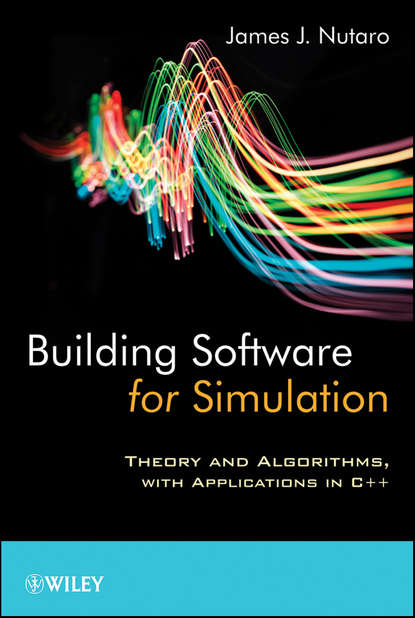Книга "Building Software for Simulation. Theory and Algorithms, with Applications in C++" представляет собой уникальное руководство по проектированию и разработке программного обеспечения для моделирования. Она содержит основные концепции и алгоритмы в одном месте, предназначена как для новичков в области моделирования и симуляции, так и для опытных специалистов. Книга объясняет проектирование и реализацию программного обеспечения для моделирования, используемого в инженерных системах, представляет соответствующие математические элементы, обсуждает концепции и разработку кода. Авторы подходят к теме с точки зрения теории моделирования и симуляции Зиглера, вводят фундаментальные концепции теории и показывают, как их применять к инженерным проблемам. В книге рассматриваются пять необходимых навыков для создания моделей сложных систем: работа с фундаментальными абстракциями для моделирования динамических систем; разработка основных алгоритмов моделирования для непрерывных и дискретных событий; объединение непрерывных и дискретных событий в единое целое; применение стратегий для тестирования симуляции; понимание теоретических основ модельных конструкций и алгоритмов симуляции. Центральные главы книги вводят, объясняют и демонстрируют наиболее важные элементы теории, необходимые для создания инструментов симуляции. Они сопровождаются примерами из робототехники, управления и связи, электроэнергетики, которые наглядно иллюстрируют, как применять концепции и алгоритмы. Читатели также изучат проектирование объектно-ориентированных программ симуляции, симуляцию с использованием многоядерных процессоров и интеграцию симуляторов в большие программные системы. Книга особенно полезна для студентов, изучающих моделирование и симуляцию в области компьютерных наук и компьютерной инженерии, а также для практикующих ученых и инженеров, занимающихся разработкой инструментов симуляции.
This book is a unique guide to designing and implementing simulation software that collects the most important simulation concepts and algorithms. It was written for both beginners and experienced professionals in the field of simulation. The book focuses on the design and development of software used for engineering large-scale systems, providing relevant mathematical principles and explaining coding. It approaches the subject through Zeigler’s theory of simulation, presenting its fundamental concepts, and demonstrating their application to engineering challenges. Readers learn five essential skills needed for creating simulations of complex systems: working with simulation abstractions, building continuous and event-based models, combining continuous and discrete components, testing simulations, and understanding the analysis of modeling structures and simulation processes. The title highlights the key chapters that explain and demonstrate the useful simulating theories, which are combined with projects to address robotics and communication systems and electric infrastructure. For readers, it becomes clear how these concepts work in practice. This is an essential text for courses concerned with creating simulation software in computer science or computer-aided design, including material for students and professionals interested in studying the granularity of theoretical principles and algorithms.
Transportați simularea. Teoria și algoritmului, cu aplicații în C++, Autor: James Nutro J. Cerin introduse teoriile de bază ale construcției programului de simulare care au fost colectate într-un loc, fericiteându-se profesioniștilor noi în domeniul ingineria creației sistemele mari și luminați amploarea matematic se aplică la probleme de aplicare. Textul prezintă științele și conceptele de bază care sunt utilizate atât pe cercetătorii noi cât și experimentați practicanți. Acest ghid explică planificarea si implementarea astfel de software folosit în inginerie ce utilizesisteme mari, dezvăluind cele mai importante obiecte matematice, discuțiile de concepte și dezvoltarea codului. Text preia subiectul din perspectiva Teoriei Ziegler da simulare, prezentând conceptele sale de bază și demonstrând cum să folosim acestea pentru a rezolva probleme inginerești. Lecturăredobinește 5Țabluri necesare pentru a construi simulări complicate sisteme: lucrarea cu imaginele fundamentale pentru a simula sistemele dinamic Efectuarea algoritmele de baza simulaj pentru modelurile de zi și ceruri aplicarea celori continuu și discreția pe un tot unitar Aplicarea strategiilor pentru verificarea unei simulari Introducerea fondamentele teoretice ale constructelor de modelare si metodele de simulăting Obiectele centrale înde rostru formează, dezbateră și demonstrează elementele ale teoriei care sunt cea mai importantă pentru construcție de tool Sunt derulate sub premisele aplicațiilor în robotica, folosirea și comunicării și sistemele electric și integrate o serie de exemple complete care clar ilustrează cum concepțiile și algorițiile sunt folosiți pentru a folosi. Leòția va exploră construire fețele simplete tipuri de program, simularea folosind procesorii multi-cadrez și completarea integratilor de simulatori cu sistemi softwaremai mari. Focul asupra software permite acest text să fie conducătorul de preferență Pentru cursuri universitare și facultățile din domeniu a fost și este una care eșuează foarte importantă lecturi pentru eseicii si ingineri practice implorați sintezarea de tool.
Электронная Книга «Building Software for Simulation. Theory and Algorithms, with Applications in C++» написана автором James Nutaro J. в году.
Минимальный возраст читателя: 0
Язык: Английский
ISBN: 9780470877982
Описание книги от James Nutaro J.
A unique guide to the design and implementation of simulation software This book offers a concise introduction to the art of building simulation software, collecting the most important concepts and algorithms in one place. Written for both individuals new to the field of modeling and simulation as well as experienced practitioners, this guide explains the design and implementation of simulation software used in the engineering of large systems while presenting the relevant mathematical elements, concept discussions, and code development. The book approaches the topic from the perspective of Zeigler's theory of modeling and simulation, introducing the theory's fundamental concepts and showing how to apply them to engineering problems. Readers will learn five necessary skills for building simulations of complicated systems: Working with fundamental abstractions for simulating dynamic systems Developing basic simulation algorithms for continuous and discrete event models Combining continuous and discrete event simulations into a coherent whole Applying strategies for testing a simulation Understanding the theoretical foundations of the modeling constructs and simulation algorithms The central chapters of the book introduce, explain, and demonstrate the elements of the theory that are most important for building simulation tools. They are bracketed by applications to robotics, control and communications, and electric power systems; these comprehensive examples clearly illustrate how the concepts and algorithms are put to use. Readers will explore the design of object-oriented simulation programs, simulation using multi-core processors, and the integration of simulators into larger software systems. The focus on software makes this book particularly useful for computer science and computer engineering courses in simulation that focus on building simulators. It is indispensable reading for undergraduate and graduate students studying modeling and simulation, as well as for practicing scientists and engineers involved in the development of simulation tools.



















